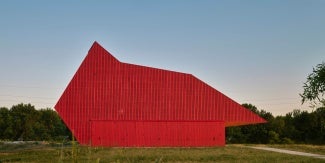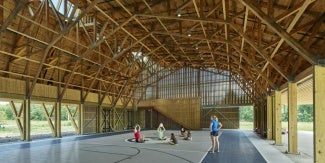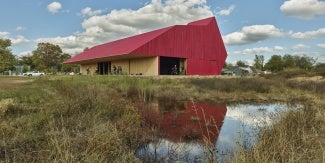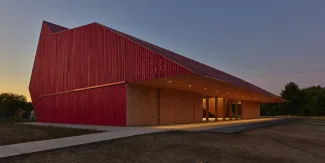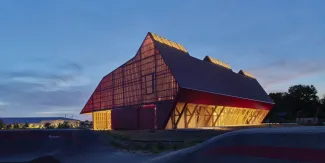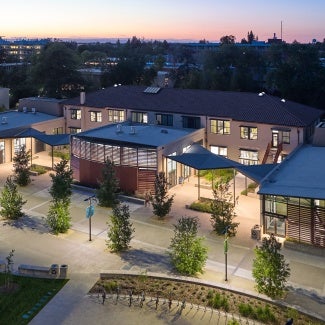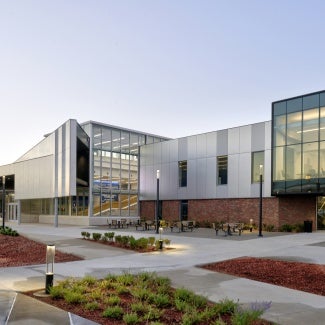Thaden Bike Barn
The award-winning education facility design of the Thaden School Bike Barn in Bentonville, AR represents a modern interpretation of a classic Ozark gambrel barn adapted to support a contemporary academic and athletic program.

Project highlights: Thaden Bike Barn
- Architecture firm: Marlon Blackwell Architects
- Owner: Thaden School
- Location: Bentonville, Ark.
- Category: Excellence
- Project site: Not previously developed
- Building program type(s): Education - K-12 school
In Bentonville, Arkansas, Thaden School is an exciting new model for education that combines a unique curriculum melding academic excellence with learning by doing. This building, guided by a master plan shaped in 2016, reinforces the school’s overarching mission and pedagogy that encourages the diverse student body to remain deeply connected to the larger community.
The plan for the campus has united two different plots through a shared street that accommodates cars, pedestrians, and cyclists equally. On one side, the school’s buildings employ a familiar Arkansas strategy where long, narrow buildings are oriented to control exposure to the intense southern sun and allow natural ventilation. On the other, the Bike Barn stands as a modern interpretation of a classic Ozark gambrel barn adapted to support a contemporary academic and athletic program.
The building sits on a berm along the campus’ eastern edge adjacent to the school’s soccer field, cyclocross course, and pump track and connects the school to a greater trail network that extends throughout the northwest region of the state. By adopting the barn form, the team ensured the project accommodates a wide range of sports, including volleyball, basketball, and cycling. It also provides the school with bike storage and additional support facilities.
A series of light-gauge wood trusses produced by a local manufacturer supports the barn’s soaring and repetitive frame. Light wood framing is reflective of local barn construction since heavy timber is uncommon in the region. The barn’s large central space is naturally ventilated and relies on minimal artificial lighting. Only its locker rooms and restrooms require active heating and cooling, and the campus geothermal energy plant provides the necessary energy.
Much like the barns that inspired it, the building has several large doors that, when opened, draw in ample additional light and fresh air and elevate its connection to the adjacent fields and bike trails. On its east and west sides, deep porches have been carved into the building’s volume, shading the large openings that look out onto the fields. Overhangs there also divert water into a restorative landscape that uses stormwater to irrigate native plants and crops that students grow on campus.
The strategies employed by the team have shaped a building that is perpetually changing, whether through the play of light and shadow across its structure or the many configurations its openings offer. At night, the Bike Barn is illuminated by LED lights that transform the building into a new beacon for the community.
Framework for Design Excellence measures
Was there a design charrette? Yes
Level of community engagement:
Consult: Stakeholders were provided with opportunities to provide input at pre-designed points in the process.
Involve: Stakeholders were involved throughout most of the process.
Collaborate: A partnership is formed with stakeholders to share in the decision-making process including development of alternatives and identification of the preferred solution.
Site area that supported vegetation (landscape or green roof) pre-development: 100%
Site area that supports vegetation post-development: 98%
Site area covered by native plants supporting native or migratory species and pollinators: 60%
Strategies used to promote Design for Ecosystems: Biodiversity, Soil conservation, Habitat conservation, Flora/fauna
Is potable water used for irrigation? Yes
Is potable water used for cooling? Yes
Is grey/blackwater reused on-site? No
Is rainwater collected on-site? Yes
Stormwater managed on-site: 100%
2030 Commitment baseline EUI: 40 kBtu/sf/yr
Predicted net EUI including on-site renewables: 38 kBtu/sf/yr
Reduction from the benchmark: 5%
Is the project all-electric? Yes
Level of air filters installed: MERV 9-11
Was a “chemicals of concern” list used to inform material selection? Yes
Do greater than 90% of occupied spaces have a direct view to the outdoors? Not applicable
Were embodied carbon emissions estimated for this project? No
Estimated service life: 100 years
Floor area, if any, representing adapting existing buildings: Not applicable
Ability to survive without utility power: Passive survivability
Risk assessment and resilience services provided: Hazard identification, Building vulnerability assessment
Has a post-occupancy evaluation been conducted? Yes
Building performance transparency steps taken:
Present the design, outcomes, and/or lessons learned to the office.
Present the design, outcomes, and/or lessons learned to the profession.
Present the design, outcomes, and/or lessons learned to the public.
Publish lessons learned from design, construction, and/or occupancy.
Project team & jury
Year of substantial project completion: 2020
Gross conditioned floor area: 830 sq. ft.
Architect: Marlon Blackwell Architects
Engineer - Civil: Ecological Design Group, Inc.
Engineer - MEP: CMTA Consulting Engineers
Engineer - Structural: Engineering Consultants Inc.
General Contractor: Crossland Construction Company
Lighting Design: Taylor & Miller
Landscape Architect: Andropogon Associates, Ltd.
Code Consultant: Code Solutions Group, LLC.
Lori Cappucio, AIA (Chair), SmithGroup, Washington, DC
Omar Bailey, AIA, Shepley Finch, Phoenix
Vince Gonzales, AIA, Seattle Public Schools, Seattle
Kandis Larsen, AIA, Integrus + YGH, Spokane, Wash.
Sindu Meier, AIA, William Rawn Associates, Milton, Mass.
The Education Facility Design Award recognize state-of-the-art education environments being developed in today's learning spaces.
Thirteen projects showcase the best in today's learning spaces

